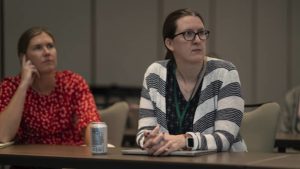
How much debt does the U.S. have? Billions of dollars? Hundreds of billions? Trillions?
The federal debt has surpassed $28 trillion, a number so large that most Americans simply cannot comprehend it, much less understand how it impacts the economy and their own lives. This ignorance is understandable. Discussions of budgets, debt and deficits often dominate the media when it comes to big spending, subsidies and government programs, but they tend to be shallow sound bites or accusations of one group trying to score political points or denigrate a policy they don’t support. These conversations leave Americans uninformed and lacking the tools they need to understand the impact on their daily lives.

As the national debt continues to rise and more Americans are unable to grasp the meaning of the trends, TFAS high school programs division, the Foundation for Teaching Economics (FTE), has developed an engaging, hands-on curriculum to help high school educators of economics, civics and history more effectively teach their students about the federal budget, debt and deficits.
The new five-part course, “Making Sense of the Federal Budget, Debt & Deficits,” explains the national budget and helps students understand how government spending works using the “economic way of thinking.” Students can test their knowledge on current debt levels, practice balancing a budget, discover the difference between mandatory and discretionary spending and more.
Each lesson in the curriculum covers a different aspect of government finance: the national debt and its historic origins; federal budget allocations; sustainability of the federal debt; federal, state and local government budgeting, spending and funding; government financial accounting and reporting; and how rational public choices can lead to budget deficits.

The course lessons are designed to spark students’ interest by engaging them with hands-on activities. In one lesson, students learn about public choice theory by role-playing as elected representatives in the House Budget Committee. They work together to determine which of 12 policies to include in a final budget proposal, facing tradeoffs between constituent desires, personal values, reelection and the financial state of the country.
FTE Executive Director Ted Tucker says the vision for the curriculum is to use economic reasoning to provide students with the powerful critical thinking tools needed to understand and discuss complex topics.
“The curriculum is designed to bring clarity and understanding to the processes and outcomes of government spending when it comes to budgeting, accumulating debt and running deficits,” he said.
Course Development
The program began as a lecture in FTE’s Economics for Leaders program for teachers. Given the significant number of questions asked during this lecture, it became clear that FTE staff needed to create a more in-depth curriculum. As part of the design process, several groups of teachers tested out the new curriculum at various one-day trainings this year. Each participant gained an appreciation for not only how challenging it is to regulate and moderate government spending, but they also gained the insight needed to teach their own students about it.

“Participating in the games from a student’s point of view provided greater insight, helping me to remember details better,” one participant shared.
Another teacher remarked, “The program provided many engaging activities to use with my students that will increase their knowledge and understanding of complex economic issues. I left feeling empowered by what I learned.”
The curriculum unit incorporates rich, academically rigorous content that takes students from the basics to a more in-depth understanding. It follows a sequence that allows each of the five lessons to build on the previous one, although teachers can use the lessons independently if they wish.
Each lesson provides background information in a section on essential understandings, which teachers can use to prepare for a class discussion or presentation. Alternately, they can assign this section as student reading for homework or class work. The lessons include key terms, economic concepts and course objectives so teachers can easily identify key takeaways for their students. Each lesson also includes an activity that incorporates the concepts from the essential understandings section.
The program provided many engaging activities to use with my students that will increase their knowledge and understanding of complex economic issues. I left feeling empowered by what I learned.” – FTE Teacher Program Participant
These activities engage students from beginning to end in problem solving, critical thinking and teamwork that leads to a more comprehensive understanding of the issues surrounding budgets, debt and deficits. All the activities include question prompts for a debriefing session, which teachers can lead discussion-style or assign to the students as writing practice. Some activities are rapid-fire quiz questions, one has students prioritize policies to make fiscal budgeting decisions, and one allows students to guess how the government spends the people’s money.

FTE has instructed teachers for years and will continue to teach these important concepts. Teachers and students alike are grateful for the interactive instruction.
“FTE is an outstanding resource for teachers,” one teacher participant said. “I’m thankful to FTE for generously supporting teacher professional development and providing access to great information and great experts.”
In addition to educating teachers and students on vital issues related to government spending, TFAS continues to promote the “economic way of thinking” among all Americans through units like this. As citizens become proficient at using economic reasoning and applying it to government policy, they will better understand how critical encouraging economic freedom is to promoting human prosperity, both in the U.S. and around the world.
Find the “Making Sense of the Federal Budget, Debt & Deficits” curriculum on FTE.org.
LESSON PLAN
Lesson 1: Our National Debt
Lesson 2: Where does our Money Go?
Lesson 3: Is Our Federal Debt Sustainable?
Lesson 4: Where are the Numbers? Tracking the Words and Tracking the Deeds
Lesson 5: Debts, Deficits and Debasement: Using Public Choice Economics to Understand Public Debt

